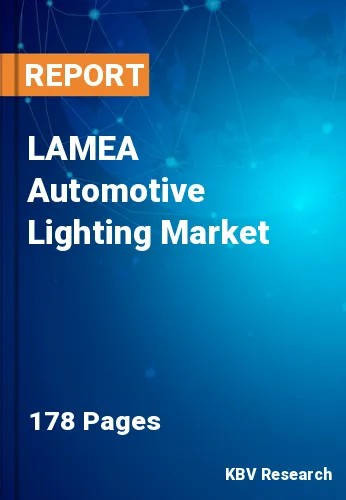The Latin America, Middle East and Africa Automotive Lighting Market would witness market growth of 9.2% CAGR during the forecast period (2023-2030). In the year 2026, the LAMEA market's volume is expected to surge to 268.3 million units, showcasing a growth of 10.9% (2023-2030).
Car lighting should be sufficiently bright so that drivers can see other road users and obstacles at night or in inclement weather. Furthermore, following the standards, the lighting must be directed to not blind other motorists. In addition, the regulations mandate various forms of illumination, including turn signals, dipped beams, fog lights, and driving lights. There must be designated locations for each of these within the vehicle. Additionally, car lighting must be weatherproof and durable to guarantee continuous visibility for an extended period of time. Automobile lighting standards are extraordinarily complex and stringent. Noncompliance with the regulations specific to each region may result in the prohibition of vehicles from accessing the road. Consequently, adequate subject expertise is crucial during the design process.
In certain circumstances, advancements in vehicle lighting technology can elevate the safety and convenience of nighttime transportation to a level comparable to that of daytime. Drivers shall no longer be obligated to speculate about what may be lurking around the corner, slithering onto the road, blinding other motorists, or contending with poor visibility caused by inclement weather, as these emerging technologies eliminate these concerns. Automakers have incorporated new technologies into every facet of vehicle illumination, including fog lights, high beams, and headlamps.
The Saudi Arabian Government is endeavoring to improve the automotive sector. According to the Industrial Center, the automotive industry projects a 12% growth rate by 2030. This growth is attributed to the country's Vision 2030 initiative. Additionally, in Brazil, the production of light and agricultural vehicles is increasing and is anticipated to grow. Four distinct light vehicle assemblers operational within the nation own a collective of nineteen industrial facilities. A compilation of machinery, construction, agricultural, and engine facilities comprises 49 establishments dispersed across 31 cities. Hence, due to the support from the governments of regional nations for the industry, increased sales of vehicles are positively impacting the market.
The Brazil market dominated the LAMEA Automotive Lighting Market, By Country in 2022, and would continue to be a dominant market till 2030; thereby, achieving a market value of $1,531.2 Million by 2030. The Argentina market is showcasing a CAGR of 9.8% during (2023 - 2030). Additionally, The UAE market would register a CAGR of 8.8% during (2023 - 2030).
Based on Position, the market is segmented into Front Lighting, Back Lighting, Side Lighting, and Interior Lighting. Based on Vehicle Type, the market is segmented into Passenger Vehicle, Commercial Vehicle, and Electric Vehicle. Based on Technology, the market is segmented into LED, Halogen and Xenon. Based on Sales Channel, the market is segmented into Aftermarket and OEM. Based on countries, the market is segmented into Brazil, Argentina, UAE, Saudi Arabia, South Africa, Nigeria, and Rest of LAMEA.
Free Valuable Insights: The Worldwide Automotive Lighting Market is Projected to reach USD 56.6 Billion by 2030, at a CAGR of 7.1%
The market research report covers the analysis of key stake holders of the market. Key companies profiled in the report include Koninklijke Philips N.V., General Electric Company, ams-OSRAM AG, Valeo SA, Stanley Electric Co. Ltd., LG Electronics, Inc. (LG Corporation), KOITO MANUFACTURING CO., LTD, HELLA GmbH & Co. KGaA, Marelli Holdings Co., Ltd. and Robert Bosch GmbH
By Position (Volume, Million Units, Revenue, USD Billion/Millon, 2019-30)
By Vehicle Type (Volume, Million Units, Revenue, USD Billion/Millon, 2019-30)
By Technology (Volume, Million Units, Revenue, USD Billion/Millon, 2019-30)
By Sales Channel (Volume, Million Units, Revenue, USD Billion/Millon, 2019-30)
By Country (Volume, Million Units, Revenue, USD Billion/Millon, 2019-30)
Our team of dedicated experts can provide you with attractive expansion opportunities for your business.

